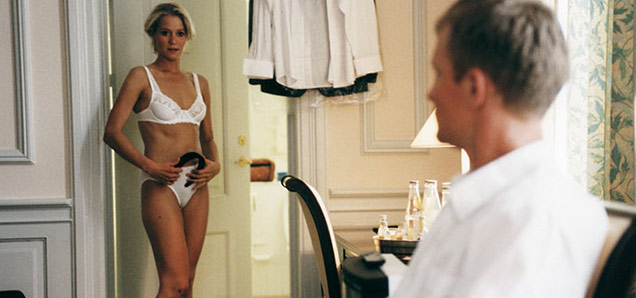Reel Life - Dogme 95: Minimalist filmmaking with avant-garde rules
 CREDIT: NIMBUS FILMS
CREDIT: NIMBUS FILMSThe use of a camcorder and natural lighting gives Festen an unusual look. Trine Dyrholm and Ulrich Thomsen are two of the stars of the film.
There has never been a better year to be an indie filmmaker than 2014. On a shoestring budget, one can easily create a film with production quality and (intentional) entertainment value that rivals a $30-million Ryan Gosling vehicle.
With the introduction of the digital workflow and cheap, accessible filmmaking, it's easy to forget how much more different and difficult the indie filmmaking scene — nay, the entire movie industry — was a mere 20 years ago.
Probably our biggest connection with the '90s and film was excess. It was a time of economic boom, and movies reflected that. Everything was bigger and badder, the explosions more explodier, the computer special effects creeping in every possible corner for more eye candy.
No more readily apparent was this to Thomas Vinterberg and Lars von Trier, two Danish filmmakers who sought to reject these bourgeois elements with their inception of the Dogme 95 filmmaking movement.
Seeking to bring film back to its roots, the movement constrained the production methods of a film severely so as to qualify as a true Dogme 95 movie, ironically setting in place its own excesses that led to the movement's downfall by 2005 (and previous films having broken many of those rules). I'm not going to list the entire set of rules, but googling Dogme 95 should give you a sense of precisely how restrictive the production criteria was.
Now of course, a filmmaking movement that rejects and seeks to do the opposite of the mainstream is nothing new; it's practically what defines the loose term “alternative cinema.” However, Dogme 95 was particularly special in having been more widely acknowledged than the confines of Andy Warhol's basement. Probably the most famous (or infamous) film of the Dogme 95 movement was its very first entry, created by none other than the movement's initiators: Festen (The Celebration).
Supposedly based on a “true” story of embellished truths, Festen was a rather amazing start to the movement, gaining international recognition and a very hearty thumbs up from the late Roger Ebert. Shot entirely with a Sony camcorder (yes, a slightly higher-end version of the camera your dad used to tape your four-year- old self running around at Disneyland), Festen is as minimalistic as it gets with the filmmaking techniques; relying entirely on handheld shots, using absolutely no lighting other than what's available, and all audio recorded by the camera's microphone. And the movie suffers not one bit.
Boasting some serious powerhouse acting (you can pick up on the intensity of their Danish even if you aren't a native speaker), Festen is, interestingly enough, about a rich, aristocratic family with a dark secret, one involving all sorts of social taboos and general awfulness. It's probably one of my most favourite “foreign” films of all time, and with that enthusiasm I refuse to divulge any further details. Watch the movie blind, knowing nothing more than the synopsis I've given. While the rough look of the film might be initially off-putting, you'll easily come to appreciate the serious story and strong performances and hey, even enjoy the gritty-looking handycam videotape look. Festen really proves that a movie can be engaging and moving without being shot on rolls of expensive 35-mm film.
I won't lie and say that I've seen the rest of Dogme 95's other significant entries, but really, if avant-garde filmmaking is your thing, chances are, you'll enjoy the 37 entries into this rather idiosyncratic film movement.













